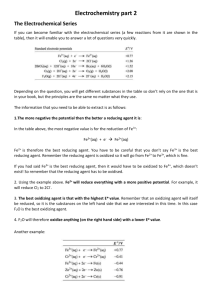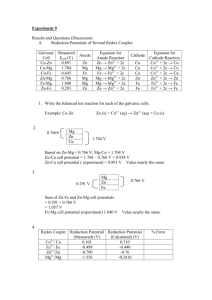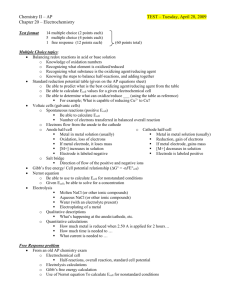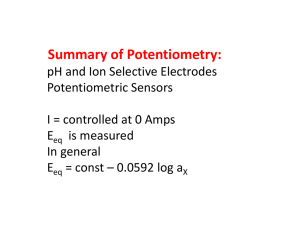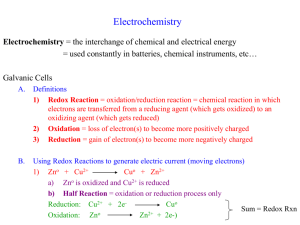Document
advertisement
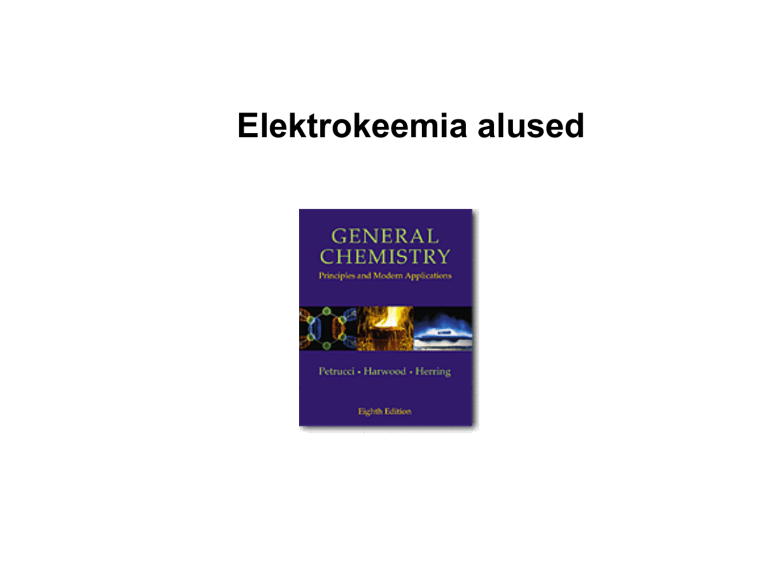
Elektrokeemia alused
Rules for Assigning Oxidation
States
Schematic for separating the oxidizing and
reducing agents in a redox reaction.
Figure 18.2: Electron flow.
Ion flow keeps the charge neutral.
The salt bridge contains a strong electrolyte.
The porous disk allows ion flow.
Schematic of a battery.
Schematic of one cell of the lead battery.
A common
dry cell
battery.
A mercury battery.
21-1 Electrode Potentials and
Their Measurement
Cu(s) + 2Ag+(aq)
Cu(s) + Zn2+(aq)
Cu2+(aq) + 2 Ag(s)
No reaction
An Electrochemical Half Cell
Anode
Cathode
An Electrochemical Cell
Terminology
• Electromotive force, Ecell.
– The cell voltage or cell potential.
• Cell diagram.
– Shows the components of the cell in a
symbolic way.
– Anode (where oxidation occurs) on the left.
– Cathode (where reduction occurs) on the
right.
• Boundary between phases shown by |.
• Boundary between half cells
(usually a salt bridge) shown by ||.
Terminology
Zn(s) | Zn2+(aq) || Cu2+(aq) | Cu(s)
Ecell = 1.103 V
Terminology
• Galvanic cells.
– Produce electricity as a result of
spontaneous reactions.
• Electrolytic cells.
– Non-spontaneous chemical change driven
by electricity.
• Couple, M|Mn+
– A pair of species related by a change in
number of e-.
21-2 Standard Electrode
Potentials
• Cell voltages, the potential differences
between electrodes, are among the most
precise scientific measurements.
• The potential of an individual electrode is
difficult to establish.
• Arbitrary zero is chosen.
The Standard Hydrogen Electrode (SHE)
Standard Hydrogen Electrode
2 H+(a = 1) + 2 e- H2(g, 1 bar)
Pt|H2(g, 1 bar)|H+(a = 1)
E° = 0 V
Standard Electrode Potential, E°
• E° defined by international agreement.
• The tendency for a reduction process to
occur at an electrode.
– All ionic species present at a=1
(approximately 1 M).
– All gases are at 1 bar (approximately 1 atm).
– Where no metallic substance is indicated, the
potential is established on an inert metallic
electrode (ex. Pt).
Reduction Couples
Cu2+(1M) + 2 e- → Cu(s)
E°Cu2+/Cu = ?
Pt|H2(g, 1 bar)|H+(a = 1) || Cu2+(1 M)|Cu(s) E°cell = 0.340 V
anode
cathode
Standard cell potential: the potential difference of a
cell formed from two standard electrodes.
E°cell = E°cathode - E°anode
Standard Cell Potential
Pt|H2(g, 1 bar)|H+(a = 1) || Cu2+(1 M)|Cu(s) E°cell = 0.340 V
E°cell = E°cathode - E°anode
E°cell = E°Cu2+/Cu - E°H+/H2
0.340 V = E°Cu2+/Cu - 0 V
E°Cu2+/Cu = +0.340 V
H2(g, 1 atm) + Cu2+(1 M) → H+(1 M) + Cu(s)
E°cell = 0.340 V
Measuring Standard Reduction
Potential
anode
cathode
cathode
anode
Standard
Reduction
Potentials
21-3 Ecell, ΔG, and Keq
• Cells do electrical work.
elec = -nFE
– Moving electric charge.
• Faraday constant, F = 96,485 C mol-1
ΔG = -nFE
ΔG° = -nFE°
Combining Half Reactions
Fe3+(aq) + 3e- → Fe(s)
Fe2+(aq) + 2e- → Fe(s)
E°Fe3+/Fe = ?
E°Fe2+/Fe = -0.440 V ΔG° = +0.880 J
Fe3+(aq) + 3e- → Fe2+(aq) E°Fe3+/Fe2+ = 0.771 V ΔG° = -0.771 J
Fe3+(aq) + 3e- → Fe(s)
E°Fe3+/Fe = +0.331 V ΔG° = +0.109 V
ΔG° = +0.109 V = -nFE°
E°Fe3+/Fe = +0.109 V /(-3F) = -0.0363 V
Spontaneous Change
• ΔG < 0 for spontaneous change.
• Therefore E°cell > 0 because ΔGcell = nFE°cell
• E°cell > 0
– Reaction proceeds spontaneously as written.
• E°cell = 0
– Reaction is at equilibrium.
• E°cell < 0
– Reaction proceeds in the reverse direction
spontaneously.
The Behavior or Metals Toward
Acids
M(s) → M2+(aq) + 2 e2 H+(aq) + 2 e- → H2(g)
E° = -E°M2+/M
E°H+/H2 = 0 V
2 H+(aq) + M(s) → H2(g) + M2+(aq)
E°cell = E°H+/H2 - E°M2+/M = -E°M2+/M
When E°M2+/M < 0, E°cell > 0. Therefore ΔG° < 0.
Metals with negative reduction potentials react with acids
Relationship Between E°cell and
Keq
ΔG° = -RT ln Keq = -nFE°cell
RT
E°cell =
ln Keq
nF
Summary of Thermodynamic,
Equilibrium and
Electrochemical Relationships.
21-4 Ecell as a Function of
Concentration
ΔG = ΔG° -RT ln Q
-nFEcell = -nFEcell° -RT ln Q
RT
Ecell = Ecell° ln Q
nF
Convert to log10 and calculate constants
The Nernst Equation: Ecell = Ecell° -
0.0592 V
n
log Q
Example
21-8
Applying the Nernst Equation for Determining E
cell.
What is the value of Ecell for the voltaic cell pictured below and
diagrammed as follows?
Pt|Fe2+(0.10 M),Fe3+(0.20 M)||Ag+(1.0 M)|Ag(s)
Example 21-8
Ecell = Ecell° -
0.0592 V
n
log Q
0.0592 V
[Fe3+]
Ecell = Ecell° log
[Fe2+] [Ag+]
n
Ecell = 0.029 V – 0.018 V = 0.011 V
Pt|Fe2+(0.10 M),Fe3+(0.20 M)||Ag+(1.0 M)|Ag(s)
Fe2+(aq) + Ag+(aq) → Fe3+(aq) + Ag (s)
Concentration Cells
Two half cells with identical electrodes
but different ion concentrations.
Pt|H2 (1 atm)|H+(x M)||H+(1.0 M)|H2(1 atm)|Pt(s)
2 H+(1 M) + 2 e- → H2(g, 1 atm)
H2(g, 1 atm) → 2 H+(x M) + 2 e2 H+(1 M) → 2 H+(x M)
Concentration Cells
0.0592 V
Ecell = Ecell° log Q
n
0.0592 V
x2
Ecell = Ecell° log 2
1
n
0.0592 V
x2
Ecell = 0 log
1
2
Ecell = - 0.0592 V log x
Ecell = (0.0592 V) pH
2 H+(1 M) → 2 H+(x M)
Measurement of Ksp
Ag|Ag+(sat’d AgI)||Ag+(0.10 M)|Ag(s)
Ag+(0.100 M) + e- → Ag(s)
Ag(s) → Ag+(sat’d) + e-
Ag+(0.100 M) → Ag+(sat’d M)
Example
21-10
Using a Voltaic Cell to Determine K
sp
of a Slightly Soluble
Solute.
With the date given for the reaction on the previous slide,
calculate Ksp for AgI.
AgI(s) → Ag+(aq) + I-(aq)
Let [Ag+] in a saturated Ag+ solution be x:
Ag+(0.100 M) → Ag+(sat’d M)
Ecell = Ecell° -
0.0592 V
n
0.0592 V [Ag+]sat’d AgI
log
log Q = Ecell° [Ag+]0.10 M soln
n
Example 21-10
0.0592 V [Ag+]sat’d AgI
Ecell = Ecell° log
[Ag+]0.10 M soln
n
x
0.0592 V
Ecell = Ecell° log
0.100
n
0.0592 V
(log x – log 0.100)
0.417 = 0 1
0.417
log x = log 0.100 = -1 – 7.04 = -8.04
0.0592
x = 10-8.04 = 9.110-9
Ksp = x2 = 8.310-17
21-5 Batteries: Producing
Electricity Through Chemical
Reactions
• Primary Cells (or batteries).
– Cell reaction is not reversible.
• Secondary Cells.
– Cell reaction can be reversed by passing
electricity through the cell (charging).
• Flow Batteries and Fuel Cells.
– Materials pass through the battery which
converts chemical energy to electric
energy.
The Leclanché (Dry) Cell
Dry Cell
Zn(s) → Zn2+(aq) + 2 e-
Oxidation:
Reduction:
2 MnO2(s) + H2O(l) + 2 e- → Mn2O3(s) + 2 OH-
Acid-base reaction:
NH4+ + OH- → NH3(g) + H2O(l)
Precipitation reaction: NH3 + Zn2+(aq) + Cl- → [Zn(NH3)2]Cl2(s)
Alkaline Dry Cell
Reduction:
2 MnO2(s) + H2O(l) + 2 e- → Mn2O3(s) + 2 OH-
Oxidation reaction can be thought of in two steps:
Zn(s) → Zn2+(aq) + 2 e-
Zn2+(aq) + 2 OH- → Zn (OH)2(s)
Zn (s) + 2 OH- → Zn (OH)2(s) + 2 e-
Lead-Acid (Storage) Battery
• The most common secondary battery
Lead-Acid Battery
Reduction:
PbO2(s) + 3 H+(aq) + HSO4-(aq) + 2 e- → PbSO4(s) + 2 H2O(l)
Oxidation:
Pb (s) + HSO4-(aq) → PbSO4(s) + H+(aq) + 2 ePbO2(s) + Pb(s) + 2 H+(aq) + HSO4-(aq) → 2 PbSO4(s) + 2 H2O(l)
E°cell = E°PbO2/PbSO4 - E°PbSO4/Pb = 1.74 V – (-0.28 V) = 2.02 V
The Silver-Zinc Cell: A Button
Battery
Zn(s),ZnO(s)|KOH(sat’d)|Ag2O(s),Ag(s)
Zn(s) + Ag2O(s) → ZnO(s) + 2 Ag(s)
Ecell = 1.8 V
The Nickel-Cadmium Cell
Cd(s) + 2 NiO(OH)(s) + 2 H2O(L) → 2 Ni(OH)2(s) + Cd(OH)2(s)
Fuel Cells
O2(g) + 2 H2O(l) + 4 e- → 4 OH-(aq)
2{H2(g) + 2 OH-(aq) → 2 H2O(l) + 2 e-}
2H2(g) + O2(g) → 2 H2O(l)
E°cell = E°O2/OH- - E°H2O/H2
= 0.401 V – (-0.828 V) = 1.229 V
= ΔG°/ ΔH° = 0.83
Air Batteries
4 Al(s) + 3 O2(g) + 6 H2O(l) + 4 OH- → 4 [Al(OH)4](aq)
21-6 Corrosion: Unwanted
In neutral solution: Voltaic Cells
O2(g) + 2 H2O(l) + 4 e- → 4 OH-(aq)
2 Fe(s) → 2 Fe2+(aq) + 4 e-
EO2/OH- = 0.401 V
EFe/Fe2+ = -0.440 V
2 Fe(s) + O2(g) + 2 H2O(l) → 2 Fe2+(aq) + 4 OH-(aq)
Ecell = 0.841 V
In acidic solution:
O2(g) + 4 H+(aq) + 4 e- → 4 H2O (aq) EO2/OH- = 1.229 V
Corrosion
Corrosion Protection
Corrosion Protection
21-7 Electrolysis: Causing
Non-spontaneous Reactions to
Occur
Galvanic Cell:
Zn(s) + Cu2+(aq) → Zn2+(aq) + Cu(s)
EO2/OH- = 1.103 V
Electolytic Cell:
Zn2+(aq) + Cu(s) → Zn(s) + Cu2+(aq)
EO2/OH- = -1.103 V
Complications in Electrolytic
Cells
• Overpotential.
• Competing
reactions.
• Non-standard
states.
• Nature of
electrodes.
Quantitative Aspects of
Electrolysis
1 mol e- = 96485 C
Charge (C) = current (C/s) time (s)
ne- = I t
F
21-8 Industrial Electrolysis
Processes
Electroplating
Chlor-Alkali Process
Focus On Membrane Potentials
Nernst Potential, Δ
Chapter 21 Questions
Develop problem solving skills and base your strategy not
on solutions to specific problems but on understanding.
Choose a variety of problems from the text as examples.
Practice good techniques and get coaching from people who
have been here before.
